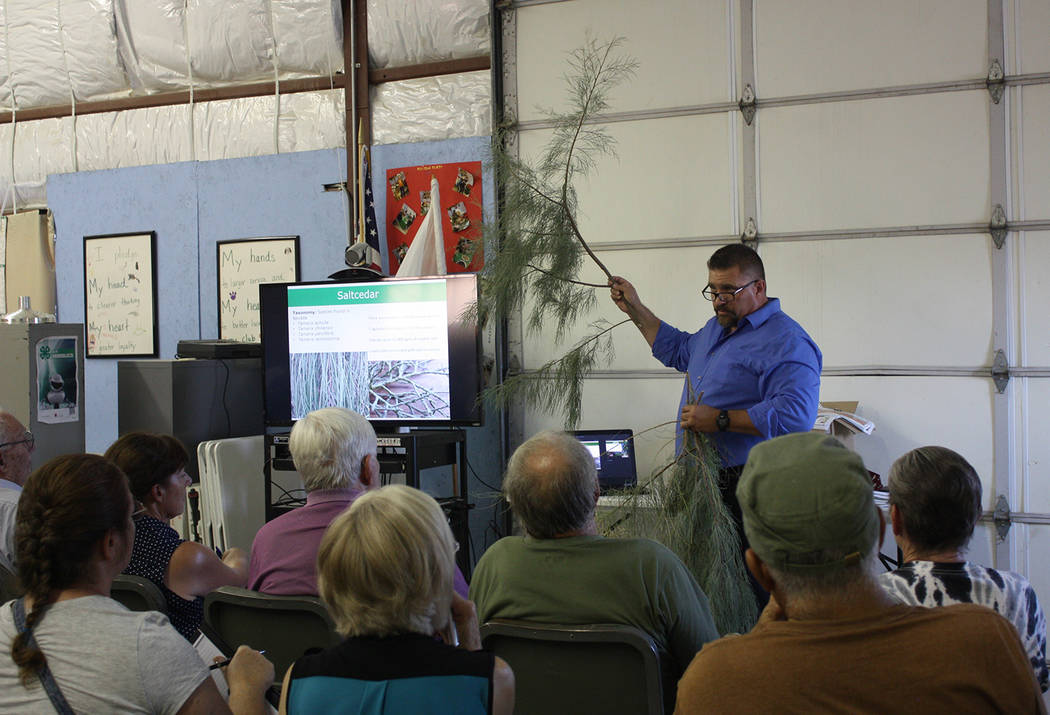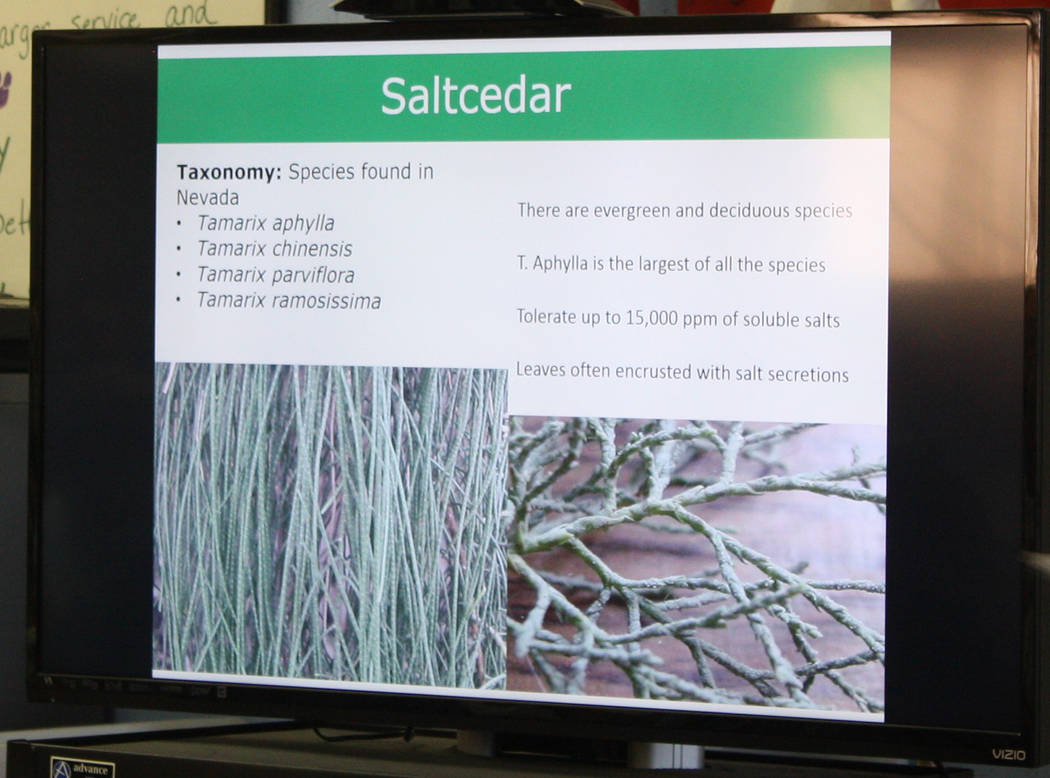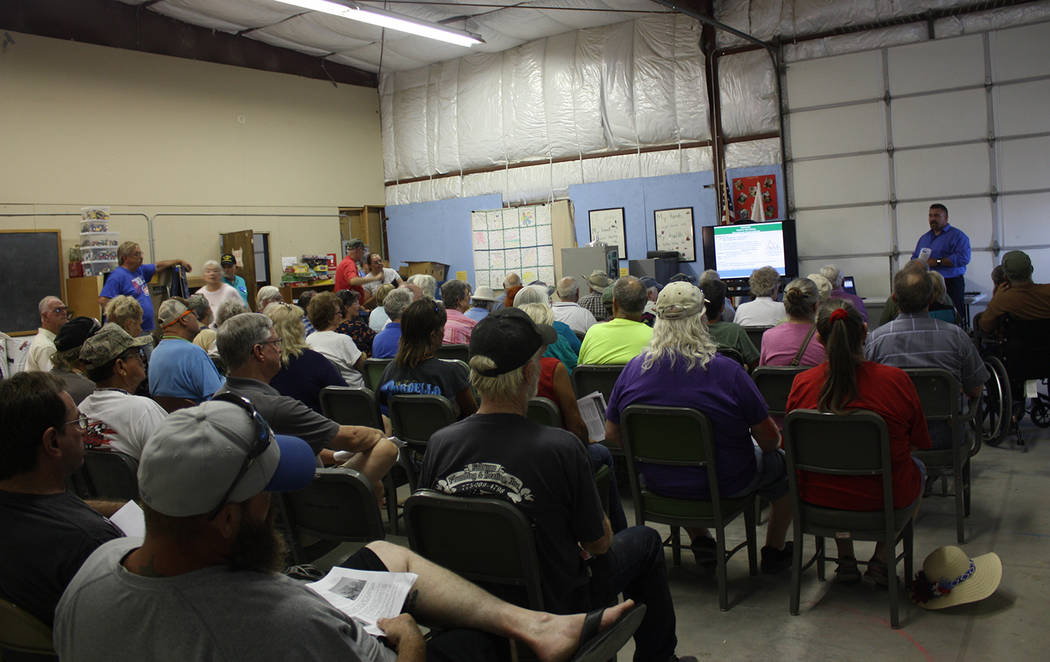Several dozen head out for Pahrump Saltcedar Control Workshop
The parking lot was packed to the limit and the sides of adjacent streets were beginning to fill up as dozens of Pahrump Valley residents prepared for an evening of education at the University of Nevada Cooperative Extension.
The topic bringing so many out on Aug. 14 was in regard to one of the most pervasive and invasive species in the West, saltcedar.
Nevada Department of Agriculture Noxious Weeds Coordinator Sean Gephart teamed up with M.L. Robinson of the UNR Cooperative Extension to host a Saltcedar Control Workshop with the aim of teaching locals how to tackle these tough-to-kill plants.
Gephart started off by explaining the history and biology of the species. According to Gephart, there are roughly 60 different types of saltcedar, although in Nevada only four are of major concern. These include tamarix aphylla, tamarix chinensis, tamarix parviflora and tamarix ramosissima. Of the four, aphylla, commonly referred to as athel, is the largest and can reach up to 100 feet in height.
Regardless of type, however, Gephart said they were all considered noxious weeds by the state of Nevada and were each capable of wreaking the same kind of damage. Although there is some difference of opinion on the amount of water saltcedars consume, it is generally agreed that the plants have a negative impact by lowering water tables. Gephart estimated that saltcedars have the ability to devour up to 14 acre-feet of water per year. For reference purposes, the Nevada state engineer’s office estimates average consumption by a residential domestic well to be 0.5-acre feet annually.
In addition to sucking up precious water resources, saltcedars hinder the environment by littering the surrounding area with salt-laden leaves. This creates soil salinity levels in which the saltcedar can thrive but that also prevents native vegetation from flourishing.
Because of these negative aspects, saltcedar has been classified as a noxious weed and according to Nevada Revised Statute 555, must be removed if required by the state quarantine officer. “Every railroad, canal, ditch or water company, and every person owning, controlling or occupying lands in this state, and every county, incorporated city or district having the supervision and control over streets, alleys, lanes, rights of way, or other lands, shall control all weeds declared and designated as noxious as provided in NRS 555.130 in any manner specified by and whenever required by the State Quarantine Officer,” NRS 555.150 states.
So that leads to the question, how does one effectively control these hardy plants? The answer is a combination of mechanical and chemical methods.
Modes of control
“Hand pulling can be effective when used on seedlings in newly infested areas where the plant has yet to establish itself,” information provided at the workshop detailed. “Mowing is used to reduce the volume of tamarisk before treatment with herbicide.”
However, residents were cautioned that mechanical means of control in established infestations will not be enough by themselves and must be combined with chemical measures in order to have the desired effect. “Burning, chopping, chaining, digging, cutting must be combined with herbicide application for the treatment to be effective. Tamarisk is able to resprout vigorously from mechanical treatments.” Gephart explained that saltcedar seeds are reported to have a 100 percent germination rate and to add even more tenacity, the plant can also reproduce from stem fragments and roots.
Chemical control can be accomplished using several different products, with Triclopyr, Glyphosate and Imazapyr listed as herbicides to utilize.
There was a focus on one particular product, called Garlon 4. This herbicide contains the active ingredient Triclopyr and is available through various retailers. According to the discussion by workshop participants familiar with the product, it can be obtained at Star Nursery or Tractor Supply in the agricultural section and it is also sold through Walmart.com as well as many other online sources.
“The active ingredient, Triclopyr, works like a growth regulator found only in plants. It enters treated vegetation through leaves, stems and bark and uses the plant’s own transportation system to move into the roots and leaves,” a question and answer sheet on Garlon 4 explained. “It reduces rapid growth, which disrupts food production and causes the plant to die from lack of nutrients.”
Anyone wishing to learn more about saltcedars and how to control them, or any other noxious weed, can contact Gephart at sgephart@agri.nv.gov or 775-353-3640.
Contact reporter Robin Hebrock at rhebrock@pvtimes.com
Utility company offers incentives for saltcedar removal
In the name of water conservation, Great Basin Water Company offers its customers bill credits in order to incentivize the removal of invasive saltcedar plants.
Utility customers can receive $75 in bill credits for each saltcedar they have removed, with a maximum $300 credit per premise. All varieties of saltcedar qualify for the program.
According to a "frequently asked questions" document available on Great Basin Water Company's website, local landscapers can assist with the removal of saltcedars and residents must provide a copy of their receipt for the removal work in order to qualify. The receipt should indicate the number of trees removed and must be submitted to the utility within 60 days of the work's completion.
There is an application form to be filled out and additional terms and conditions also apply.
For more information visit www.myutility.us and select "water conservation" under the education drop down menu, email bewatersmart@greatbasinwaterco.com or call 844-694-4404.



















